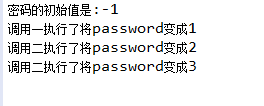一.“级联”调用
1.程序源代码
1 packageclass6;2
3 public classMyCounter {4
5 private int password = -1;6
7
8 //调用本类(1)
9 publicMyCounter transfer1()10 {11 MyCounter test = newMyCounter();12 test.password = 1;13 System.out.println("调用一执行了"+"将password变成"+test.password);14 returntest;15
16 }17
18 //调用本类(2)
19 public MyCounter transfer2(intpassword)20 {21 this.password =password;22 System.out.println("调用二执行了"+"将password变成"+this.password);23 return this;24 }25
26 public static voidmain(String[] args) {27
28 MyCounter test = newMyCounter();29 System.out.println("密码的初始值是:"+test.password);30 test.transfer1().transfer2(2).transfer2(3);31 }32
33 }
2.结果截图

二.String类的常见函数
1.Length():用一个String类的对象来调用,返回这个字符串的长度.
eg.String str;
int length = str.Length();//此时的length就是该字符串的长度
2.charAt():返回指定索引处的char值。索引范围是从0到length() - 1。对于数组索引,序列的第一个char值是在索引为0,索引1,依此类推。
声明:public void charAt(index);其中index指的是索引值.
eg.
1 packagecom.yiibai;2
3 import java.lang.*;4
5 public classStringDemo {6
7 public static voidmain(String[] args) {8
9 String str = "This is yiibai";10
11 //prints character at 1st location
12 System.out.println(str.charAt(0));13
14 //prints character at 5th location i.e white-space character
15 System.out.println(str.charAt(4));16
17 //prints character at 18th location
18 System.out.println(str.charAt(17));19 }20 }
3. getChars():截取字符串中指定长度,指定起始位置的一段字符声明:void getChars(int sourceStart,int sourceEnd,char target[],int targetStart)
sourceStart指定了子串开始字符的下标,sourceEnd指定了子串结束后的下一个字符的下标。
因此,子串包含从sourceStart到sourceEnd-1的字符。接收字符的数组由target指定,target中开始复制子串的下标值是targetStart。
eg.
1 String str = "abcdefghikl";2 Char[] ch = new char[8];3 str.getChars(2,5,ch,0);
4.replace():方法用于在字符串中用一些字符替换另一些字符,或替换一个与正则表达式匹配的子串。
声明:StringObject.replace(regexp/substr,replacement)
regexp/substr规定了子字符串或要替换的模式的 RegExp 对象。如果该值是一个字符串,则将它作为要检索的直接量文本模式,而不是首先被转换为 RegExp 对象。
replacement规定了替换文本或生成替换文本的函数。
eg.
1 String s = "I Love Java!";2 String r = "you";3 s = s.replace("I",r);4 System.out.println(s);
5. toUpperCase():方法用于把字符串转换为大写。
eg.
String s ="abcd";
System.out.printfln("未修改前的字符串是:"+s);
s=s.toUpperCase();
System.out.printfln("修改后的字符串是:"+s);
6. toLowerCase(): toUpperCase():方法用于把字符串转换为小写。
eg.
String s ="ABCD";
System.out.printfln("未修改前的字符串是:"+s);
s =s.toUpperCase();
System.out.printfln("修改后的字符串是:"+s);
7.trim():去掉字符串首尾的空格。
eg.
1 public static voidmain(String arg[])2 {3
4 String a=" I Love Java ";5
6 String b="I Love Java";7
8 System.out.println(b.equals(a)); //false
9
10 a=a.trim();//去掉字符串首尾的空格
11
12 System.out.println(a.equals(b)); //true
13 }
8.toCharArray():该方法的作用是返回一个字符数组,该字符数组中存放了当前字符串中的所有字符
eg.
1 public classclass6_32
3 {4 public static voidmain(String args[])5 {6 String str="I Love Java";7
8 char[] c=str.toCharArray();9
10 System.out.println("数组c的长度为:"+c.length);//11
11
12 System.out.println(c);//I Love Java
13
14 }15
16 }
三.String.equals()方法源码
1 1.*@param obj the reference object with which to compare.2 2. * @return {@code true} if thisobject is the same as the obj3 3. * argument; {@code false} otherwise.4 4. *@see #hashCode()5 5. *@see java.util.HashMap6 6. */7 7. public booleanequals(Object obj) {8 8. return (this ==obj);9 9. }10 1./**11 2. * Compares this string to the specified object. The result is {@code12 3. * true} if and only if the argument is not {@codenull} and is a {@code13 4. * String} object that represents the same sequence of characters as this14 5. * object.15 6. *16 7. *@paramanObject17 8. * The object to compare this {@codeString} against18 9. *19 10. *@return{@codetrue} if the given object represents a {@codeString}20 11. * equivalent to this string, {@codefalse} otherwise21 12. *22 13. *@see#compareTo(String)23 14. *@see#equalsIgnoreCase(String)24 15.*/25 16. public booleanequals(Object anObject) {26 17. if (this ==anObject) {27 18. return true;28 19. }29 20. if (anObject instanceofString) {30 21. String anotherString =(String) anObject;31 22. int n =value.length;32 23. if (n ==anotherString.value.length) {33 24. char v1[] =value;34 25. char v2[] =anotherString.value;35 26. int i = 0;36 27. while (n-- != 0) {37 28. if (v1[i] !=v2[i])38 29. return false;39 30. i++;40 31. }41 32. return true;42 33. }43 34. }44 35. return false;45 36. }





















 2000
2000











 被折叠的 条评论
为什么被折叠?
被折叠的 条评论
为什么被折叠?








